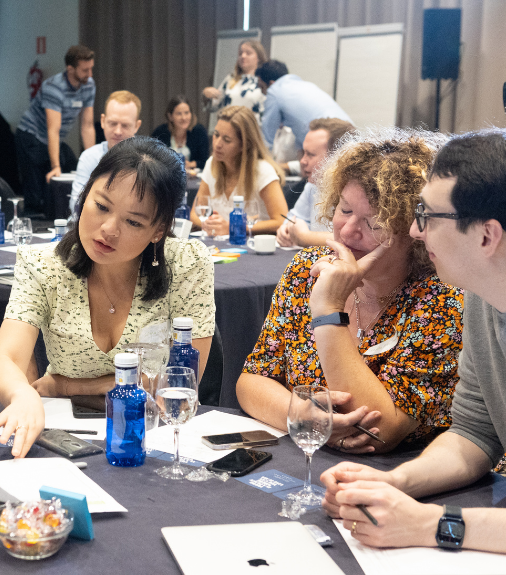We use cookies to help you navigate efficiently and perform certain functions. You will find detailed information about all cookies under each consent category below.
The cookies that are categorized as "Necessary" are stored on your browser as they are essential for enabling the basic functionalities of the site. ...
Necessary cookies are required to enable the basic features of this site, such as providing secure log-in or adjusting your consent preferences. These cookies do not store any personally identifiable data.
Functional cookies help perform certain functionalities like sharing the content of the website on social media platforms, collecting feedback, and other third-party features.
Analytical cookies are used to understand how visitors interact with the website. These cookies help provide information on metrics such as the number of visitors, bounce rate, traffic source, etc.
Performance cookies are used to understand and analyze the key performance indexes of the website which helps in delivering a better user experience for the visitors.
Advertisement cookies are used to provide visitors with customized advertisements based on the pages you visited previously and to analyze the effectiveness of the ad campaigns.
Other cookies are those that are being identified and have not been classified into any category as yet.

In the grand tapestry of the corporate world, where interconnectedness and competition reign supreme, organizations are on an endless quest for that elusive competitive edge. But here’s the kicker: one key to unlocking unparalleled innovation and untapped talent is often hidden in plain sight.
Reading time: 2 minutes
Neurodiversity. A term that encompasses a breathtaking array of neurological differences – autism, ADHD, dyslexia, and more, is woven into the intricate fabric of our human genome – a nuanced tapestry of human cognition often overlooked. Embracing neurodiversity isn’t just a moral compass that should be guiding organizational leaders towards inclusivity; it is also a strategic treasure map leading to unparalleled advantages.
Changing the narrative around neurodiversity is important to this end. Although some forms of neurodiversity are legally recognized as disabilities, enabling access to support and protections, there persists a sociologically embedded assumption that neurodiversity equates to a “disability.” This is a mistake and a fundamentally flawed assumption. Neurodiversity is a spectrum of talents, perspectives, and potentials and should be considered as such. While of course, it can be harder for a neurodivergent person to navigate a world created by neurotypical people, for neurodivergent people, it does not mean there is “no ability”.
In fact, a more accurate label would be “different ability”. It should be of no surprise that Richard Branson, Charles Schwab, Barbara Corcoran, Ingvar Kamprad, Elon Musk, and a number of other well-known CEOs have touted their neurodivergence.
Making adaptations for the way neurodivergent individuals work is often confined to the realm of accommodation – a polite gesture towards inclusion. Yet, there’s a bolder path, one that beckons us toward a far more powerful integration.
Imagine not just extending an invitation but actively involving neurodivergent individuals in shaping the very essence of an organization. It’s a voyage from “accommodate” to “co-create” and it all begins with leadership.
Leaders, the compass bearers of any organization, must champion inclusivity. They need to be seasoned in the art of empathy and openly dispel myths and preconceptions that shroud neurodiversity. It’s about recognizing the talents and thinking styles neurodiverse individuals bring to the table – as individuals. In the same way neurotypical individuals all bring different talents and thinking styles to the table. To do this effectively, leadership teams must engineer inclusive environments that nourish neurodiversity — by boasting clear communication, flexibility, and customized support. But that’s just the tip of the iceberg.
Hierarchical structures are often ill-suited to the neurodiverse landscape. Flexibility, collaboration, and innovation must be the new building blocks; and indeed, a bi-product of COVID, is that the rigidity of structures and the working patterns of old have been disrupted in a way that makes new space for flexibility – in ways the world has embraced better than ever before. Take this redesign a step further and picture agile teams, seamlessly merging diverse talents to create groundbreaking solutions.
Amongst the arsenal of unique skills that neurodiverse individuals bring to the table, problem-solving skills are regularly cited as one of them. Eagle-eyed attention to detail that spots the minutest of errors, pattern recognition wizardry that unravels complex mysteries, and a penchant for creative problem-solving that takes the scenic route to solutions. The Sherlock Holmes, data wizards, and innovation catalysts of the corporate world.
All these traits find their moment to shine in fields including – and importantly, not exclusively in – data analysis, software development, marketing, CRM, quality assurance, and research etc; i.e. roles where detail, patterns, and/or creativity reign supreme – and are roles that are easy to identify within any organization.
While there are many ways to make recruiting processes more accessible, this would be the place to start, to identify potential barriers to fostering genuine inclusivity. Aside from logistical and practical improvements that can be made to make jobs more accessible and available to those with neurodiverse needs, a focus on skills, abilities, and aptitudes over solely relying on traditional educational qualifications, stands out as the first and most effective way to remove potential roadblocks. The benefit of this approach extends far beyond a neurodiversity perspective, proven also to enable social mobility.
Then here’s where the true alchemy of inclusive workplaces happens; making every individual feel welcome, valued, and at home. Embedding initiatives such as mentorship programmes; a mutually beneficial pairing to guide employees in navigating the maze of an organisation. All the while using this powerful relationship to meaningfully identify areas with the greatest need for change, acting as a catalyst for adaptation to support the needs of individuals – which also benefits the organization as a whole. A mutually beneficial culture, thriving on open communication, where every voice is celebrated.
But how do we know if we’re on the right track? As the old adage goes, we are what we measure, and so metrics as ever, become our guiding stars. Retention rates, promotion rates, and project completion rates become the litmus tests for success. Diligent progress tracking, and tweaking strategies to ensure neurodiversity initiatives bear fruit.
The neurodiversity advantage isn’t just a noble endeavor; it’s a strategic imperative. Those who seize it today will shape a future where inclusivity, innovation, and prosperity reign supreme — a true testament to the power of diversity and the art of embracing the human spectrum in all its glorious variations.
Q5 has a Talent & Future Workforce offering that embeds a focus on Diversity, Equity, Inclusion, & Belonging.
If these are topics you’re grappling with, get in touch to find out more.

Managing Director of Q5 North America
